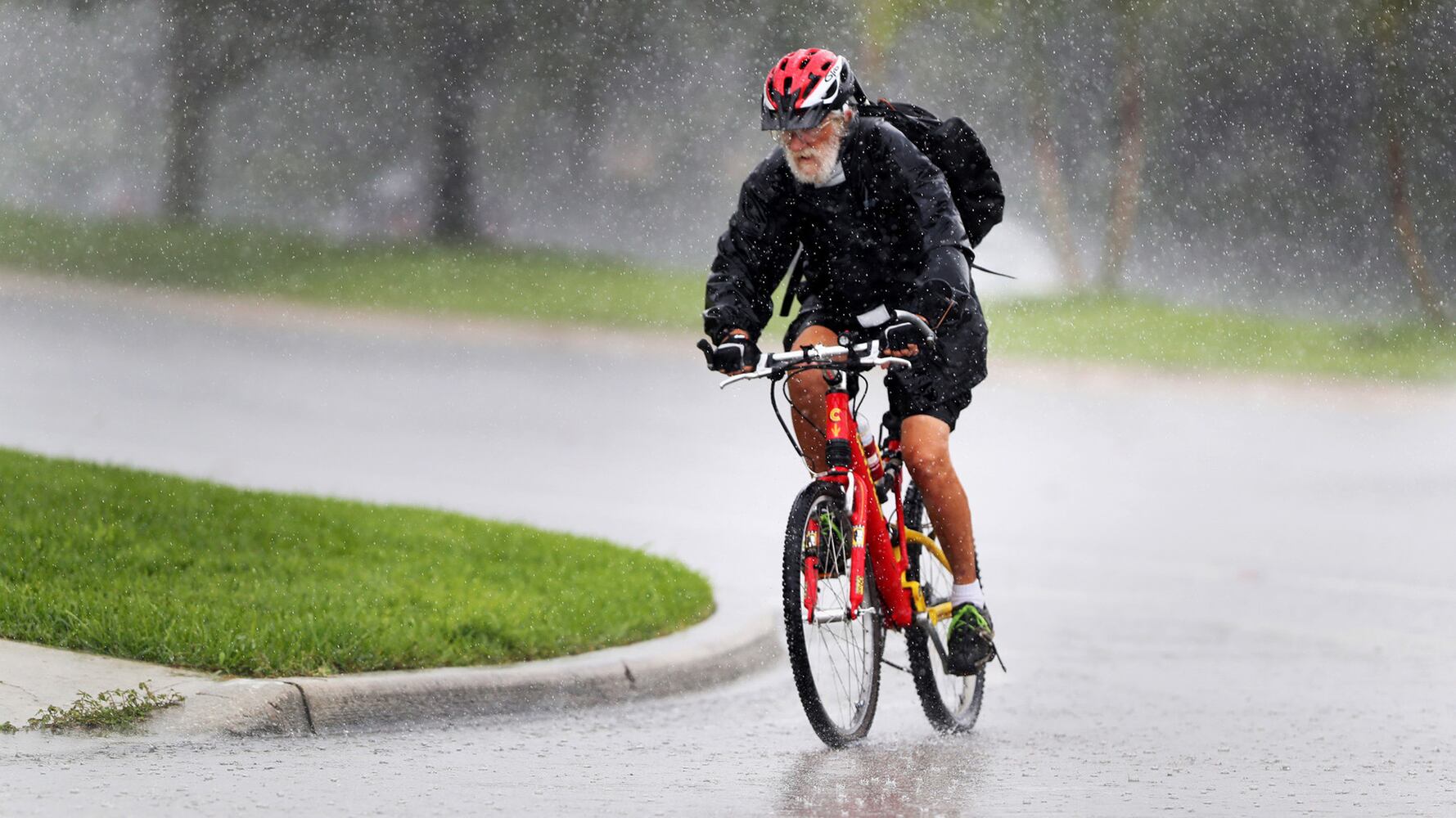A weakened but resilient Tropical Storm Elsa killed at least one person in Florida on Wednesday and injured several others when a possible tornado struck a campground at a Navy base in southeast Georgia.
The National Hurricane Center said Elsa still packed 45 mph winds more than six hours after making landfall along Florida’s northern Gulf Coast. The storm’s center was near Valdosta, Georgia, by 5 p.m. Wednesday.
Elsa seemed to spare Florida from significant damage, though it still threatened flooding downpours and caused several tornado warnings. The coasts of Georgia and South Carolina were under a tropical storm warning. Forecasters predicted Elsa would remain a tropical storm into Friday, and issued a tropical storm watch from North Carolina to Massachusetts.
Authorities in Jacksonville, Florida, said one person was killed Wednesday when a tree fell and struck two cars. The National Weather Service reported 50 mph wind gusts in the city. The tree fell during heavy rains, said Capt. Eric Prosswimmer of the Jacksonville Fire Rescue Department. He said no one else was injured.
In nearby Camden County, Georgia, a possible tornado struck a park for recreational vehicles at Kings Bay Naval Submarine Base. About 10 people were injured and taken to hospitals by ambulance, said base spokesman Scott Bassett. The extent of their injuries was not immediately clear. He said some buildings on the base appeared to have been damaged as well.
Tropical Storm Elsa made landfall late Wednesday morning in Taylor County, Florida, along the Sunshine State’s Big Bend area on the Gulf Coast, according to the National Hurricane Center.
Despite having now weakened into a tropical storm, Elsa is still bringing heavy rains, high winds, flooding and downed power lines in its wake.
In its 11 a.m. advisory, the National Hurricane Center said the storm made landfall with maximum sustained winds clocking 65 mph.
Gov. Brian Kemp reminded Georgians of his executive order issued Tuesday ahead of the storm, and urged everyone to “stay safe.”
The counties under the state of emergency are Appling, Atkinson, Bacon, Baker, Baldwin, Ben Hill, Berrien, Bibb, Bleckley, Brantley, Brooks, Bryan, Bulloch, Burke, Calhoun, Camden, Candler, Charlton, Chatham, Chattahoochee, Clay, Clinch, Coffee, Colquitt, Columbia, Cook, Crawford, Crisp, Decatur, Dodge, Dooly, Dougherty, Early, Echols, Effingham, Emanuel, Evans, Glascock, Glynn, Grady, Hancock, Houston, Irwin, Jeff Davis, Jefferson, Jenkins, Johnson, Jones, Lanier, Laurens, Lee, Liberty, Long, Lowndes, Macon, Marion, McDuffie, McIntosh, Miller, Mitchell, Montgomery, Muscogee, Peach, Pierce, Pulaski, Quitman, Randolph, Richmond, Schley, Screven, Seminole, Stewart, Sumter, Tattnall, Taylor, Telfair, Terrell, Thomas, Tift, Toombs, Treutlen, Turner, Twiggs, Ware, Warren, Washington, Wayne, Webster, Wheeler, Wilcox, Wilkinson and Worth.
Gov. Ron DeSantis said at a morning news conference that no major structural damage or deaths from the storm had been reported.
“Clearly, this could have been worse,” the Republican governor said, adding that many storm-related deaths come after the system passes. “Be very careful when you’re working to clear debris.”
According to local media reports, more than 20,000 people were without power in the Tampa Bay area, mostly in Hillsborough, Pinellas and Polk counties that surround Tampa Bay. Crews were working to restore electricity and DeSantis said no hospitals reported an outage, which has been a major problem in past storms.
Elsa was forecast to cross from Florida into southeast Georgia on Wednesday afternoon, and the National Hurricane Center issued a tropical storm warning for the state’s entire 100-mile coast. Elsa was expected to bring 2 to 4 inches of rain to Georgia as it churns to the northeast before entering South Carolina to the west of Savannah early Thursday. By Friday, the storm’s effects were expected to be felt as far north as New England.
Credit: National Weather Service
Credit: National Weather Service
The storm complicated the search for potential survivors and victims in the collapse of a Miami-area condominium on June 24. Despite that challenge, crews continued the search in the rubble of Champlain Towers South in Surfside, Florida, on the state’s southeast coast.
The storm also temporarily halted demolition work Wednesday on the remainder of an overturned cargo ship that’s partially submerged off the coast of Georgia. The South Korean freighter Golden Ray capsized in September 2019 off St. Simons Island, about 70 miles south of Savannah. Crews have dismantled and removed more than half the ship since November.
Elsa is already the third tropical system to hit South Carolina. In June, Tropical Storm Claudette moved across the northern part of the state after making landfall in Louisiana and Tropical Storm Danny hit land near Hilton Head Island. Both storms caused only minor damage.
Meanwhile, the U.S. Coast Guard said 13 people were rescued from a boat that had left Cuba with 22 people aboard late Monday. Nine people remained missing.
Elsa is the earliest fifth-named storm on record, said Brian McNoldy, a hurricane researcher at the University of Miami.
Forecasters said Elsa would slice across inland north Florida as a tropical storm with strong rains and wind, then move on to Georgia, the Carolinas and Virginia before heading out in the Atlantic Ocean by Friday.
Schools and government offices in the Tampa area were closed and most public events postponed as Elsa approached Tuesday. Tampa Mayor Jane Castor, however, predicted hockey’s Stanley Cup finals game between the Tampa Bay Lightning and Montreal Canadiens would be played as scheduled Wednesday night.
Earlier Tuesday, Elsa swept past the Florida Keys but spared the low-lying island chain a direct hit. Still, there were heavy rains predicted in the Keys through Wednesday, along with strong winds.
To the north in South Carolina, emergency officials were watching Elsa, but no evacuations were ordered during the peak summer beach tourism season.
The storm was expected to track inland, but coastal forecasters noted the worst weather was on the east side of the storm and could dump up to 5 inches of rain and bring wind gusts up to 55 mph in places like Hilton Head Island, Charleston and Myrtle Beach.
Vidalia, Georgia, officials said Elsa’s currently projected track brings the storm’s eye near the city Wednesday evening. “This means those in the path of the storm could see winds up to 73 mph,” city officials said. “The Vidalia area could start seeing higher than normal winds starting around midday tomorrow. Currently, our area is forecast to receive 2-4 inches of rain.
“At this time, it appears that our area could potentially see some flooding in low-lying areas, isolated power outages and downed trees,” officials said.
Russ Bynum and Curt Anderson of The Associated Press contributed to this report.
About the Author
The Latest
Featured



